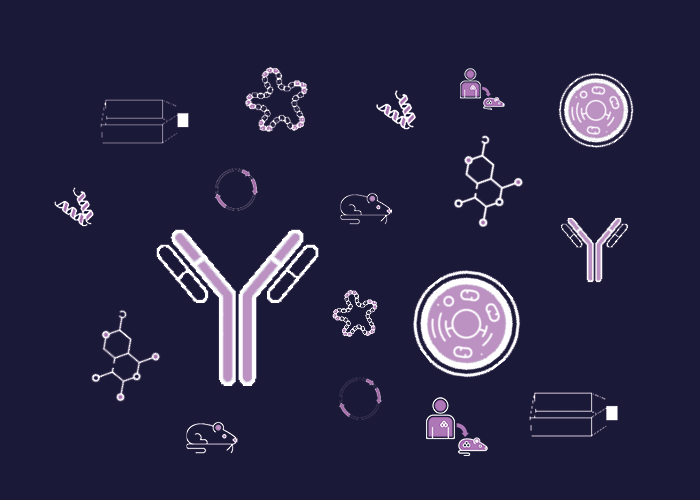Cat. #152733
Anti-5-Hydroxymethylcytosine (5hmc) [AB3/63.3] mAb
Cat. #: 152733
Sub-type: Primary antibody
Unit size: 100 ug
Availability: 3-4 weeks
Target: 5-Hydroxymethylcytosine (5hmC)
Class: Monoclonal
Application: IF ; IP ; DB
Reactivity: All
Host: Rat
£300.00
This fee is applicable only for non-profit organisations. If you are a for-profit organisation or a researcher working on commercially-sponsored academic research, you will need to contact our licensing team for a commercial use license.
Contributor
Inventor: Wolf Reik
Institute: Babraham Institute
Tool Details
*FOR RESEARCH USE ONLY (for other uses, please contact the licensing team)
- Name: Anti-5-Hydroxymethylcytosine (5hmc) [AB3/63.3] mAb
- Research fields: Genetics;Stem cell biology
- Clone: AB3/63.3
- Tool sub type: Primary antibody
- Class: Monoclonal
- Conjugation: Unconjugated
- Reactivity: All
- Host: Rat
- Application: IF ; IP ; DB
- Description: The anti-5-Hydroxymethylcytosine antibody, clone AB3/63.3, detects 5-hydroxymethyl cytosine (hmc, 5hmc), but not 5-methylcytosine or unmethylated cytosine. 5-Hydroxymethylcytosine is a DNA pyrimidine nitrogen base. It is formed from the DNA base cytosine by adding a methyl group and then a hydroxy group. Every mammalian cell contains 5-hydroxymethylcytosine, but the levels vary depending on the cell type; generally, the levels of 5-hydroxymethylcytosine increase with age. Although the exact function has not been fully elucidated, studies suggest that 5-hydroxymethylcytosine may regulate gene expression or initiate DNA demethylation.
- Immunogen: 5-Hydroxymethylcytosine conjugated to BSA
- Isotype: IgG2a kappa
- Recommended controls: Unmodified DNA, 5-Methylcytosine DNA, and 5-hydroxymethylcytosine DNA
Target Details
- Target: 5-Hydroxymethylcytosine (5hmC)
- Tissue cell line specificity: Unmodified DNA, 5-Methylcytosine DNA, and 5-hydroxymethylcytosine DNA
- Target background: The anti-5-Hydroxymethylcytosine antibody, clone AB3/63.3, detects 5-hydroxymethyl cytosine (hmc, 5hmc), but not 5-methylcytosine or unmethylated cytosine. 5-Hydroxymethylcytosine is a DNA pyrimidine nitrogen base. It is formed from the DNA base cytosine by adding a methyl group and then a hydroxy group. Every mammalian cell contains 5-hydroxymethylcytosine, but the levels vary depending on the cell type; generally, the levels of 5-hydroxymethylcytosine increase with age. Although the exact function has not been fully elucidated, studies suggest that 5-hydroxymethylcytosine may regulate gene expression or initiate DNA demethylation.
Applications
- Application: IF ; IP ; DB
Handling
- Format: Liquid
- Concentration: 1 mg/ml
- Unit size: 100 ug
- Storage buffer: PBS with 0.02% azide
- Storage conditions: -20° C
- Shipping conditions: Dry ice
References
- Zhang et al. 2014. PLoS One. 9(1):e84925. PMID: 24427299.
- Cao et al. 2014. Theriogenology. 81(3):496-508. PMID: 24315686.
- Alterations of epigenetic signatures in hepatocyte nuclear factor 4a deficient mouse liver determined by improved ChIP-qPCR and (h)MeDIP-qPCR assays.
- Dynamic reprogramming of 5-hydroxymethylcytosine during early porcine embryogenesis.
- Ficz et al. 2011. Nature. 473(7347):398-402. PMID: 21460836.
- Dynamic regulation of 5-hydroxymethylcytosine in mouse ES cells and during differentiation.
- Wossidlo et al. 2011. Nat Commun. 2:241. PMID: 21407207.
- 5-Hydroxymethylcytosine in the mammalian zygote is linked with epigenetic reprogramming.

![Anti-5-Hydroxymethylcytosine (5hmc) [AB3/63.3] has been used for hydroxymethylated DNA immunoprecipitation (hMeDIP) with enrichment of the target compared to negative controls. (Zhang et al. 2014. PLoS One. 9(1)](https://cancertools.org/wp-content/uploads/a1fe6938-42da-4122-820d-ddf6f5bc8355.jpg)


